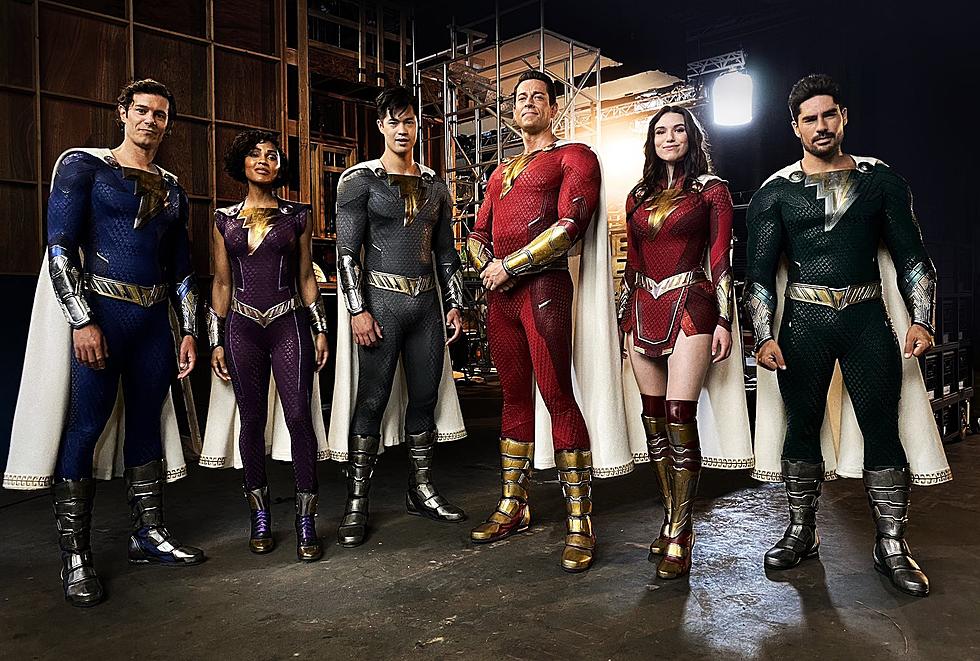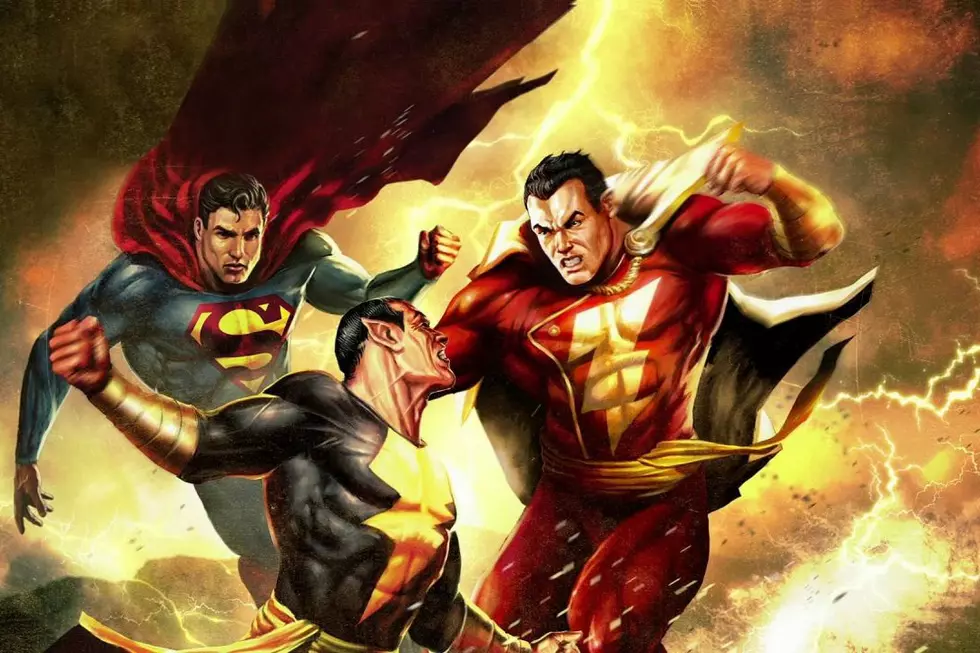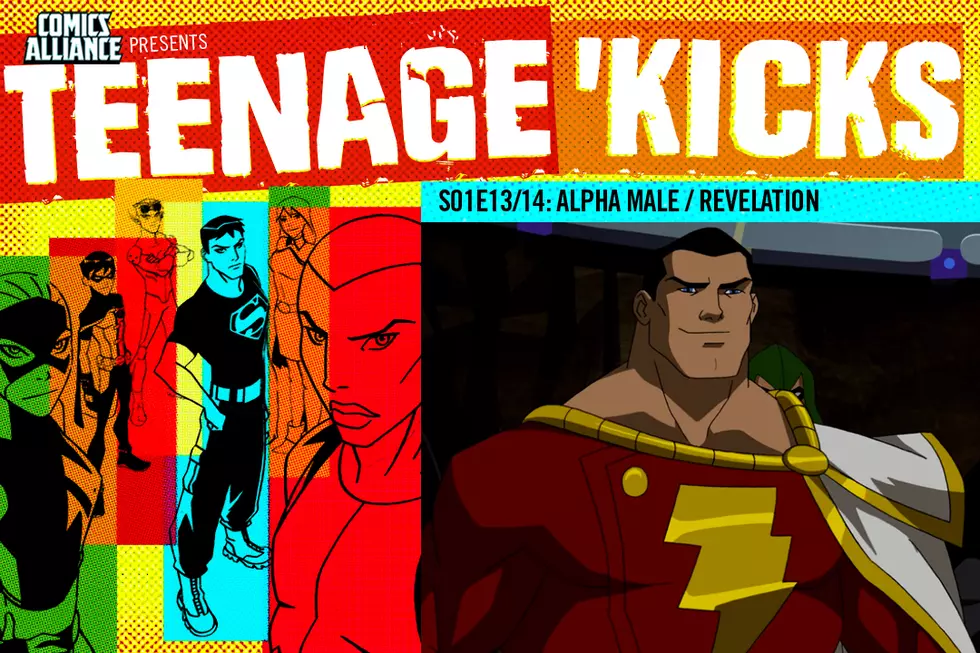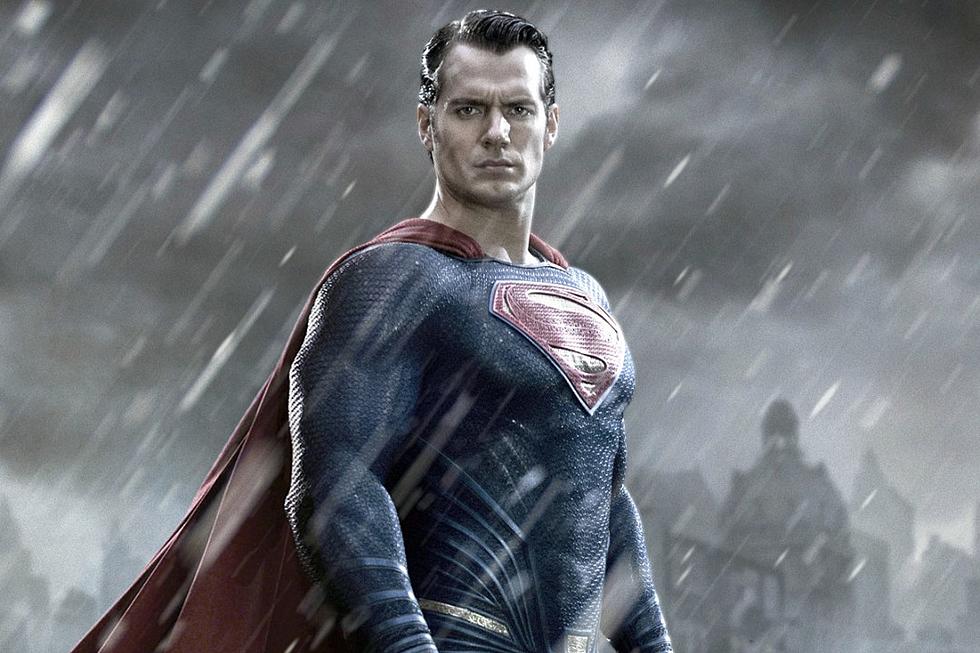![Five Stars: Starting At The End With Jeff Smith [Interview]](http://townsquare.media/site/622/files/2017/03/smith-bone2.jpg?w=630&h=420&zc=1&s=0&a=t&q=89&w=980&q=75)
Five Stars: Starting At The End With Jeff Smith [Interview]
There are few cartoonists more admired than Jeff Smith. Inspired himself by the serialized newspaper strips he read as a child, Smith went on to create a string of acclaimed, inspirational comics works that have not only proved evergreen in terms of story, but have brought in generation after generation of new excited cartoonists to make their own comics.
Often described as an overnight success, the reality is that Smith worked for years in relative obscurity before self-publishing the series that made his name: Bone, the story of three cousins who journey across countless landscapes --- sometimes together, often apart --- and the various strange and intriguing folk they meet along the way.
As a self-publisher, Smith set up a company called Cartoon Books, originally comprised of just one employee: Jeff Smith. However, over time the rigors of self-publishing meant that his wife Vijaya ultimately left her job to join him --- and the company grew in subsequent years to bring in several other staffers, many of whom are still there today.
Bone was published in a serialized format from 1991-2004, with a new story called Bone: Coda released in 2016 that put a cap to the series. It marked one of Smith's most notable traits as a storyteller: the need for his works to have a definitive beginning, middle, and end.
Smith always works to make sure he has an ending in place before he starts writing the beginning of each story, with his subsequent self-published stories RASL and Tuki: Save The Humans both adhering to that rule. As a result, his narratives always have a sense of consistency: he knows where he's heading, and every story until that point leads the reader closer to that conclusion.
Following the conclusion of Bone, Smith stretched out into more experimental areas: his series Tuki: Save The Humans was released as a webcomic before coming to print, and RASL was not only aimed at an older readership, but featured a notably different storytelling approach in the art style. Though best known for his self-published work, Smith has also worked on stories for other publishers, partnering with DC for a Shazam miniseries in 2007 as part of a larger project at the publisher, which also brought in Kyle Baker at the same time for a run on Plastic Man.
Throughout his career, Smith has proven one thing: careful planning and a considered approach behind the scenes always leads to the most enjoyable storytelling on the page. Having won a number of Eisners in several categories, Smith remains an eclectic, energetic presence within comics --- which led him naturally to his current role as the festival director for Comics Crossroads Columbus, which sees the best new and established cartoonists in the world head to the State every year.
Always experimenting, always pushing forward; there's a reason why Jeff Smith is one of the most admired cartoonists working in the medium today.
Bone: Coda
Written and drawn by Jeff Smith
Published by Cartoon Books, 2016
ComicsAlliance: As you always do for your own creative process, let's start things with the ending. For the anniversary of Bone last year, you published a new story, Bone: Coda. What led you to return to the story with a coda that follows on from the finale of your original run?
Jeff Smith: It was the 25th anniversary and we wanted to do something… the question was what. I had loosely sketched up a story that immediately followed the final chapter of Bone for a different project that was meant to be a children’s book, but ultimately put it on the shelf. During a staff meeting, we hit on the idea of me finishing the new chapter, and rounding out the book with behind the scenes essays full of photos and memories, kind of like the extras on a Blu-ray film, but as a companion volume to the Bone series. I especially wanted to thank people in the comics community who went out of their way to help me in the early days.
CA: Going from the original Bone comics and returning to that world now, do you feel your approach to how you sequence a page and tell a story has shifted - or was it easy to return back to the style of those first stories?
JS: I wondered if I could still draw the Bone cousins the way I used to. You’re right, styles change and evolve, but the boys came back to me right away, almost as if I never stopped. My line is a little shakier, maybe, and I have a tendency nowadays to work in widescreen panels, but otherwise it felt very much like going home.
Bone
Written and drawn by Jeff Smith
Published by Cartoon Books, 1991
CA: Some of your earliest influences were in animation --- and in fact, you started out in animation yourself. When did you decide to make the move into comics? When did you first feel that this was the best medium for telling the story you wanted?
JS: I always wanted to work in comics. Animation was a way station while I figured out how to break in. Originally the goal was to create a Bone comic strip for the newspapers, but I wasn’t having much luck.
If I were to narrow it down to one moment, I think the pivot to comic books came during a speech I heard Bill Watterson give at the Festival of Cartoon Art on the Ohio State University campus in 1989. Watterson was lamenting the shrinking size of comic strips since their heyday, and generally warning against the forces of commerce that were stifling creativity. That speech had a profound effect on me, and afterward I went outside and sat under a tree in front of the student union.
I don’t know how long I sat there, I lost track of time. What I heard was the death knell of the medium I loved.
At the same time, I had just rediscovered comic books. First [Art] Spiegelman’s Maus, then [Frank] Miller’s The Dark Knight Returns lured me into comic book shops only a few years earlier where I discovered underground books like Love & Rockets, Eightball, and self-published work like Cerebus. So that was it. From that moment on, I wanted Bone to be a self-published underground comic book. I stood up, returned to the conference and never looked back. No more waiting for someone’s permission to draw, and to my surprise, it turned out the space and format of multi-page books suited my skills much better than the four panels of strips.
CA: How did the setup and creation of Cartoon Books come together, and how important was it for you to have that support structure in place during that time, and moving forward?
JS: Very important. No one could do this alone. From the very beginning, my wife Vijaya helped me create a business plan and kept the books. Even so, she still had a full time job and I had to write, draw, edit the letters page, create covers and logos… by hand… before Photoshop, write solicitation texts for the distributors’ catalog, and then print the books.
When things took off, and I suddenly was overwhelmed with reorders, shipping, mail, and requests of all kinds, to do appearances or interviews, I had to hire my first assistant, a young comics fan in the Bay area named Garrett Chin. But within a few months the workload grew to the point where I asked Vijaya to quit her job and become my partner full-time and run the business end of things. I needed to concentrate on making the comics and promoting them. That worked out pretty well.
Now, twenty-five years later, Vijaya and I have two full-time assistants who help us with traveling to shows, managing our production schedule, and licensing the books and characters. As of now, Bone has been translated into 30 languages, with more coming all the time. I still write and draw every line in my comics, but dealing with printers, Hollywood, lawyers, contracts, travel, foreign publishers and all that jazz is dealt with by Vijaya and Kathleen Glosan. Manning the comic convention booth, Photoshop and coloring the books is now done by Tom Gaadt. It’s a great group. And we like each other.
Next year will be Kathleen’s twentieth year with us, and Tom’s eighteenth! Our staff meetings cover business matters as well as creative ones. I count on them every day, and they always have my back.
CA: For me, what distinguishes Bone almost immediately is your sense of character design: the Bone cousins themselves; the dragons; that giant leaf creature… What’s your process for working out what characters like Fone Bone, Smiley Bone and Phoney Bone should look like? Their design, their posture, their expression?
JS: It’s really just knowing what you like, and trying to get the thing to work the way it needs to. This is definitely an oversimplification, but when I’m drawing, it comes down to two schools of cartooning: Disney --- specifically Carl Barks and Walt Kelly, who both came out of that studio with strong senses of character construction and appeal. And MAD Magazine --- the wild and unruly art of Sergio Aragones, Al Jaffee, Don Martin and Mort Drucker that oozes humor and individuality. And of course, Harvey Kurtzman, the architect of MAD. Without Harvey, we’d all be wandering in the wilderness.
RASL
Written and drawn by Jeff Smith
Published by Cartoon Books, 2008
CA: RASL was quite a change of pace, perhaps aimed at older readers, and with this strong sci-fi noir influence and a single protagonist. How did you decide on this being your follow-up to Bone? Were you deliberately seeking to find something that’d be seen as a marked difference, in terms of tone and content?
JS: I know, right? What was I thinking? Terry Moore said it freaked him out to see Jeff Smith drawings doing dirty things!
No, it wasn’t deliberate. In fact, the concept for RASL started out very differently, more cartoony. Early sketches of the main character looked like something out of manga. But the idea evolved as it developed. I started with parallel universes, then layered on film noir, and added a dash of Tesla and conspiracy theories… the next things I needed were a villain and a femme fatale. It ended up being a smokier, harder comic than Bone, not just to be different, but because it was fantastic to work on. I really enjoyed writing and drawing that book.
CA: From a storytelling perspective, what most strikes me about RASL is the choice to use wider panels, feature more 'silent' panels, and decompress somewhat. Did you approach this as an opportunity to strike outwards, try different modes of storytelling within the comics medium, and experiment with your sequencing?
JS: I did. The wider panels were a nod to the cinematic origins of noir, and the story itself was non-linear to evoke the dislocation that the main character feels living in multiple universes. Writing from a first person perspective, that is, with the reader only knowing what RASL knows or has witnessed personally, was a challenge. It makes exposition really tough. In Bone, I could always cut to the bad guys and show them scheming, but in RASL, the main character has no idea who the bad guys even are.
As far as my sense of pacing, or style of panel-to-panel transitions go, I didn’t consciously change that up at all. I’ve always done decompressed storytelling. Starting with the first issue of Bone, you’ll find silent panels and drawn out sequences. That’s how I do! Probably because of what I was saying earlier, how I planned and practised for four-panelled comic strips and then discovered comic books with almost unlimited space --- I just stretched out and enjoyed myself.
Shazam: The Monster Society of Evil
Written and drawn by Jeff Smith
Published by DC Comics, 2007
CA: People may not have expected you to do a mini series at DC --- but if there was one character that people could ever have predicted you’d work on, I think it would’ve been Billy Batson. How did you come to the world of work-for-hire, and how did you end up using the Shazam characters?
JS: It was DC’s idea. The way I heard it, during an editorial meeting it was asked if they could get anyone on any project, who and what would it be? The consensus was Kyle Baker on Plastic Man and me on Shazam. I agreed, because as you said there are elements to the character that suit me. Wizards, mythology and talking tigers. What’s not to like?
CA: What was it like writing someone else’s characters --- and with DC in general? Did you find there was enough to reach into and work with, to explore?
JS: Enough. The Rock of Eternity gave me some interesting metaphysics to chew on. Researching the original comics by C.C. Beck and Bill Parker made it clear that Billy and the Captain were two separate individuals that somehow shared the same space. That not only tied into the weird quantum physics of the Rock of Eternity, but also gave me the idea that Captain Marvel was something like a genie in a bottle who could be called upon for help. That notion of jinn mythology helped me explain Tawky Tawny the talking tiger… because if I made him a jinn, he could shape shift from man to beast. In the original stories, Tawny was a normal tiger in India that accidentally drank a bowl of magic milk or something.
Anyway, at that point, I had all the characters connected to the powers of the Rock of Eternity through the Wizard. Next, I needed a story and an emotional journey for Billy. I picked the Monster Society of Evil because it is the most famous Captain Marvel adventure from the Golden Age, and also because it’s the most awesome title ever. Billy would learn that he had a sister out there somewhere he didn’t know about, so he goes from living alone on the street to having family and friends around him. Mary Marvel as the younger sister turned out to be the highlight of the project for me.
I mean, the characters were fun to write and draw, and you can’t ask for more than that. Working with DC was great. I had two stipulations before accepting the job. One: that DC would approve my entire script in advance so once I started I could just go without interference. And two: that no other superheroes exist in the world… this is a Captain Marvel only world. They agreed, as long as I didn’t say that no other superheroes exist. Ah! Perfect!
Tüki: Save The Humans
Written and drawn by Jeff Smith
Published by Cartoon Books, 2013
CA: Your next project was Tüki: Save The Humans, a travelling adventure story. It seems like this is a style you’re fond of; is it fair to say that you’re interested in world-building on the fly; of sending your characters out into an unknown where anything can happen?
JS: Yes, to an extent. Especially on a longer work, allowing yourself the freedom to explore and follow whims of inspiration keeps the work fresh --- not just for me, but for the characters and hopefully the readers. The thing stays alive when the characters are curious and unsure. But you can’t make things up out the blue. There need to be rules to the world and structure to the story. An outline.
As you said at the very beginning of this interview, I always start a project by figuring out the ending. This is a serious effort, and it takes time to play with the characters and imagine a journey. It’s not hard, and usually the ending comes in an emotional moment of inspiration, but I have to wait for it…because until that happens, I don’t know if the story is worth telling. Only then do I go back and fill in an outline that will guide the characters and build to that conclusion.
CA: For Tüki you published the story as a webcomic, rather than as a series of single print issues. Was this a response to shifts in the marketplace, and the way people consume comics? Have you had to reconsider the approach that Cartoon Books makes to actually putting out your stories?
JS: The Internet is changing everything… the way we listen to music, how we get our news, how we read, even our politics. Yes, we wanted to dip our toe into the world of webcomics. There are cartoonists over the years whose work online I admire… Kate Beaton, Allie Brosh, Faith Erin Hicks, Scott Kurtz, Dash Shaw, to name a few… I wanted to take a crack at it. Try an experiment. I figured if it didn’t work out, I could always go back to print publishing.
Tuki is an interesting case. I’m about a hundred pages into it, but… because on the web you load the story up one or two pages at a time, I approached the project as a series of Sunday comics, like Flash Gordon or Prince Valiant. That was a lot of fun, but I’m not sure that was the best thing for Tuki itself. When we reprinted the story later in comic book form, some of the pages flowed, some didn’t. There was a start and stop quality. My bad. Long story short, through no fault of the Internet, my brief, wondrous life as a web cartoonist is over for now. Tuki will return, though. It’s going to take a little reworking, some major, some minor.
The strip is on hiatus, but it’ll be back, just in a different form.
CA: You’ve made a habit of being unpredictable, and taking on a number of different roles within the comics industry that aren’t just writing or drawing comics --- right now you’re heavily involved in organizing the CXC Festival, for example. With Tüki on hiatus and Bone: Coda wrapped, what are you currently focused on? Do you have new comics in the works, or are you presently happily occupied elsewhere, with projects like CXC?
JS: I finally wrapped up the children’s book I was working on, and I am currently revamping Tuki. It’s early days, but it’s looking good. My side projects do take up a lot of time. Especially CXC. But these efforts are part of comics to me. They are promotion, not just for my work, but for comics in general, which is something I’ve always been passionate about. CXC, or Cartoon Crossroads Columbus, combines two things I love: Comics and my hometown. It takes place every Fall. This year will be our third festival, and it seems to be growing fast. It’s a four-day festival that focuses on all disciplines of cartooning and cartoonists.
CXC is an outgrowth of the OSU Festival of Cartoon Art that I mentioned earlier where I heard Watterson speak. In fact, Vijaya and I partnered with Lucy Caswell, the founding curator of the Billy Ireland Cartoon Library and the original festival, to launch CXC. My job as president and artistic director is to build a coalition among the art institutions in our city. For example, we might have the Wexner Center for the Arts bringing in animation guests, the OSU Billy Ireland Cartoon Library & Museum and the Columbus College of Art & Design bringing in strip and comic book artists.
Last year, the Wex and the Billy teamed up to bring Garry Trudeau to town. The Columbus Museum of Art sponsored Ron Wimberly, who was the Thurber House Graphic Novelist in Residence and also mounted an exhibition of his work in the museum. The year before that, CCAD brought in Art Spiegelman and Francoise Mouly for the show.
We also try to bring together veterans and master cartoonists with the next generation at the comics marketplace downtown in the Columbus Metropolitan Library. Seeing Sergio Aragones chatting with Katie Skelly, or Jaime Hernandez having dinner with Lalo Alcaraz is kind of what it’s about for me. The cartooning community.
I interviewed Raina Telgemeier in front of a full room of young girls who all, when asked, raised their hands to say they want to be cartoonists. I remember how important it was to meet people who had made it, who’d been out there. It’s a way of paying forward all the generosity that was shown to me when I was starting out. I think that’s a big part of all my unpredictable roles, as you called them. Whether it was the Self-Publishing Movement, the Trilogy Tour, editing Best American Comics, or even being on the Board of the Comic Book Legal Defense Fund, it’s about promoting comics as an art form and supporting the work of other cartoonists.
Also, I get to hang out with all these creative cats. Yes --- Comics with a capital “C” keeps me happily occupied, and hopefully will for as long as I can hold a pencil.
Jeff Smith is a cartoonist whose work includes the pioneering long-form series Bone, published by his own company, Cartoon Books. In addition to his various comics works including Tuki: Save The Humans and RASL, he is also the festival director for Cartoon Crossroads Colombus (CXC), which this year will take place from September 28 - October 1st. He can be found at his website here.
Five Stars is an interview feature in which Steve Morris looks back over an artist’s career by discussing five of their milestone works.
More From ComicsAlliance









